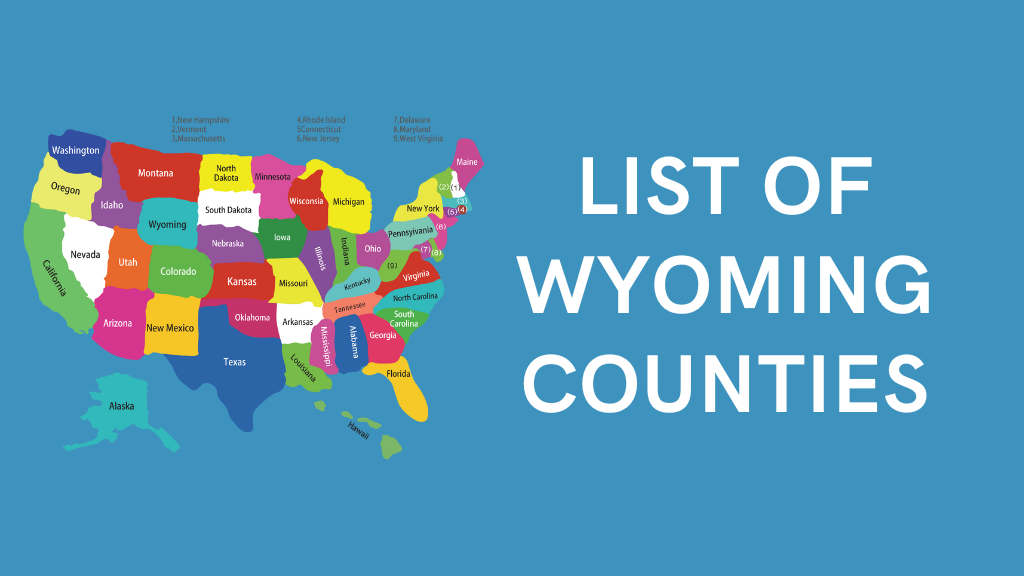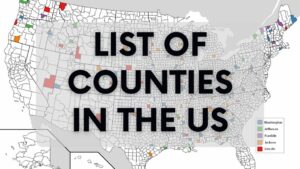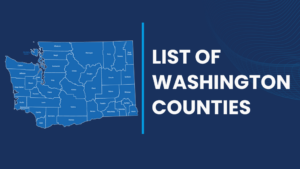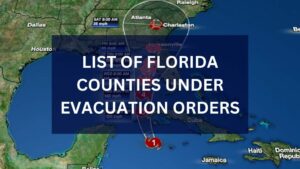Wyoming, often referred to as the Equality State, is famous for its breathtaking mountains, expansive plains, and rich western heritage. Learning about the list of Wyoming counties gives a clear picture of how the state is organized and how each area contributes to its culture, economy, and identity. Every county has its own story, blending history, natural beauty, and community spirit. From counties with thriving cities to those surrounded by quiet wilderness, Wyoming’s county system reflects both tradition and progress.
Overview of Wyoming’s Counties
Wyoming is divided into twenty-three counties, each with a county seat that serves as the hub of governance and local activity. While some counties are bustling with industry and tourism, others remain rooted in agriculture and traditional ranching. The wide-open spaces make Wyoming one of the least densely populated states in the nation, yet its counties together create a mosaic of culture and heritage. Exploring them individually reveals the true character of this state.
List of Counties in Wyoming
Albany County
Albany County is located in southeastern Wyoming and is best known as the home of Laramie, where the University of Wyoming resides. This makes it a center for higher education and research, drawing students from across the state and beyond. The county has a mix of outdoor adventure, including access to the Medicine Bow National Forest, alongside a vibrant cultural scene supported by art galleries and theaters. Ranching continues to thrive in the region, preserving its strong western traditions. Albany County is a balanced blend of history, education, and natural beauty.
Big Horn County
Big Horn County lies in the north-central part of Wyoming, with Basin and Greybull serving as its key communities. The area is dominated by the dramatic Bighorn Mountains, which provide endless opportunities for hiking, fishing, and camping. Agriculture, particularly cattle ranching and crop production, is vital to the local economy. Historical sites across the county showcase Wyoming’s early settlements and Native American heritage. Big Horn County is a place where natural beauty and cultural history intersect.
Campbell County
Campbell County, located in the northeastern part of Wyoming, is famously called the “Energy Capital of the Nation.” Gillette, the county seat, is a modern, fast-growing city fueled by coal, oil, and natural gas industries. This energy production makes Campbell County one of the most economically significant in the state. Despite its industrial power, the county also offers family-friendly communities, schools, and cultural centers. Its balance of economic opportunity and modern lifestyle has made it a magnet for new residents.
Carbon County
Carbon County stretches across southern Wyoming and is rich in both history and natural landscapes. Rawlins, the county seat, is known for its railroad heritage and historic penitentiary site. The town of Saratoga is a popular destination thanks to its mineral hot springs, fishing, and outdoor recreation. The county’s name reflects its coal mining history, which once played a major role in Wyoming’s growth. Today, tourism, ranching, and outdoor pursuits sustain the region while honoring its historic roots.
Converse County
Converse County sits in east-central Wyoming, with Douglas as its county seat. The Oregon Trail passes through the area, making it historically important in the westward expansion. Ranching and energy development form the backbone of the local economy, while small towns across the county preserve a strong sense of community. Douglas is well-known for hosting events such as the Wyoming State Fair, which celebrates agriculture and cowboy traditions. Converse County combines frontier history with modern Wyoming life.
Crook County
Crook County occupies the northeastern corner of Wyoming and is most famous for Devils Tower, the nation’s first designated National Monument. Sundance, the county seat, embraces western traditions while serving as a gateway to the surrounding Black Hills region. Ranching and timber are key industries here, alongside a growing tourism sector tied to outdoor adventure. The county is deeply connected to Native American culture and geological wonders. Crook County represents a unique mix of natural landmarks and frontier history.
Fremont County
Fremont County, one of the largest in Wyoming, stretches across central parts of the state. It is home to the Wind River Range, a stunning mountain chain attracting climbers, hikers, and adventurers. The Wind River Indian Reservation is also located here, preserving the culture and traditions of the Eastern Shoshone and Northern Arapaho tribes. Towns like Lander and Riverton balance local commerce with outdoor recreation. With rivers, mountains, and cultural diversity, Fremont County showcases both Wyoming’s heritage and natural wonders.
Goshen County
Goshen County lies in southeastern Wyoming and has Torrington as its county seat. The economy here is largely based on agriculture, with farms and ranches producing livestock, sugar beets, and corn. The county is also an important transportation hub because of its proximity to Nebraska and Colorado. Community events and rodeos highlight the county’s deep agricultural traditions. With a close-knit atmosphere and fertile farmlands, Goshen County reflects Wyoming’s strong rural identity.
Hot Springs County
Hot Springs County, one of the smallest in Wyoming, is best known for its natural mineral springs. Thermopolis, the county seat, is home to Hot Springs State Park, which draws thousands of visitors each year for therapeutic bathing and outdoor recreation. The county also offers dinosaur museums, historical landmarks, and access to the scenic Wind River Canyon. Ranching remains important, but tourism has become the lifeblood of the economy. Despite its small size, Hot Springs County has an outsized appeal.
Johnson County
Johnson County, located in north-central Wyoming, has a fascinating past tied to the Johnson County War of the late 1800s, a range conflict between large cattle barons and smaller settlers. Buffalo, the county seat, reflects this history with museums and preserved sites. Nestled against the Bighorn Mountains, the area is also a paradise for hikers, hunters, and anglers. Johnson County embodies the spirit of the Old West while welcoming visitors with modern amenities. Its landscape and history together define its character.
Laramie County
Laramie County is Wyoming’s most populous and home to the state capital, Cheyenne. As a center of government, business, and culture, it plays an essential role in the state’s identity. Cheyenne is famous for Cheyenne Frontier Days, one of the largest rodeo and western festivals in the world. Beyond its urban energy, the county also has a strong ranching base and scenic plains. Laramie County is where Wyoming’s western spirit meets political and cultural leadership.
Lincoln County
Lincoln County lies in western Wyoming and is defined by its rugged landscapes, mountains, and rivers. Kemmerer, the county seat, is notable as the birthplace of J.C. Penney and as a community rooted in coal mining and fossil exploration. Outdoor recreation, from hunting to fishing, adds to its character. Alpine and other towns in the county are surrounded by forests and lakes, making it a hub for nature lovers. Lincoln County merges history, commerce, and natural adventure.
Natrona County
Natrona County, located in central Wyoming, has Casper as its seat and largest city. Casper is a hub of energy production, particularly oil and natural gas, and serves as one of the most vibrant cultural centers in the state. The county boasts museums, theaters, and sporting venues, making it a place of activity and opportunity. Its location along the North Platte River adds outdoor recreation to its urban life. Natrona County balances industry, history, and entertainment.
Niobrara County
Niobrara County, located in eastern Wyoming, is the least populated county in the state. Lusk, the county seat, reflects the area’s quiet and rural lifestyle. Ranching dominates the local economy, and the open grasslands define its landscape. Despite its small population, the community is tightly connected and maintains a rich sense of heritage. Niobrara County is ideal for those seeking solitude, traditional ranch culture, and wide-open spaces.
Park County
Park County is located in northwestern Wyoming and serves as a gateway to Yellowstone National Park. Cody, the county seat, was founded by the legendary showman Buffalo Bill Cody and still embraces that western heritage. Tourism drives the economy, with thousands visiting Yellowstone and the Buffalo Bill Center of the West each year. Outdoor recreation, including fishing and horseback riding, is abundant. Park County’s combination of natural beauty and cultural pride makes it a must-see destination.
Platte County
Platte County lies in southeastern Wyoming, with Wheatland as its county seat. Agriculture, especially livestock and crops, continues to play a vital role in its economy. The county also offers reservoirs, lakes, and scenic landscapes for recreation. Its history is tied to the Oregon Trail, with several landmarks still preserved. Platte County provides a slower pace of life while giving access to both farming traditions and outdoor activities.
Sheridan County
Sheridan County is located near the Montana border and is celebrated for its lively cultural scene and historical richness. Sheridan, the county seat, blends western heritage with modern art, theaters, and shopping districts. The Bighorn Mountains offer stunning natural escapes nearby. Sheridan County has long been considered one of the most livable areas in Wyoming due to its community spirit and economic stability. Its mix of history, culture, and natural charm sets it apart.
Sublette County
Sublette County, in western Wyoming, is home to the Wind River Range and countless lakes and rivers. Pinedale, the county seat, offers a small-town feel with access to some of the best outdoor recreation in the state. Ranching remains an important tradition, but natural gas production has become a key part of the local economy. With its combination of natural beauty, economic resources, and welcoming community, Sublette County exemplifies the Wyoming lifestyle.
Sweetwater County
Sweetwater County is vast and resource-rich, with Rock Springs and Green River as its main towns. Mining, especially trona and coal, drives the local economy, making it one of Wyoming’s industrial powerhouses. The county is also home to Flaming Gorge Reservoir and Killpecker Sand Dunes, both major outdoor attractions. Sweetwater’s large land area provides plenty of space for adventure, industry, and community life. It represents the balance of energy development and natural exploration.
Teton County
Teton County is internationally famous for Jackson Hole, Grand Teton National Park, and its proximity to Yellowstone. Tourism is the primary driver here, with visitors coming year-round for skiing, hiking, and luxury travel. Jackson, the county seat, is known for its art galleries, high-end shops, and cultural events. Despite its popularity, the county works hard to preserve its stunning landscapes and wildlife. Teton County blends natural grandeur with modern sophistication.
Uinta County
Uinta County sits in the southwestern corner of Wyoming, bordering Utah. Evanston, the county seat, has a rich railroad history, reflected in its historic downtown buildings and cultural sites. The county also offers access to the Uinta Mountains and Bear River, making it attractive to outdoor adventurers. Agriculture and ranching remain important, alongside modern industries. Uinta County is a gateway between Wyoming and the Mountain West.
Washakie County
Washakie County, located in north-central Wyoming, honors its namesake, Chief Washakie of the Shoshone tribe. Worland, the county seat, is a small but active community focused on agriculture, particularly sugar beets and barley. The county also features museums and cultural centers that reflect its Native American and pioneer past. With fertile lands and a strong sense of heritage, Washakie County stands as a proud example of Wyoming tradition.
Weston County
Weston County lies in northeastern Wyoming, with Newcastle as its county seat. It is known for its strong ranching economy, scenic drives, and quiet lifestyle. The area has historic sites tied to the railroad and early settlers, adding cultural depth to its identity. Weston County’s residents value community, tradition, and the open spaces that define the Wyoming way of life. Its peaceful atmosphere makes it an inviting part of the state.
Importance of Wyoming’s County System
Each of Wyoming’s counties adds something unique to the state’s character. Some, like Campbell and Sweetwater, fuel the economy through energy and mining, while others like Teton and Park focus on tourism and natural beauty. Counties such as Laramie and Natrona provide cultural and political leadership, while rural areas preserve ranching traditions and a slower pace of life. Exploring the list of Wyoming counties gives deeper insight into the balance of history, culture, and natural resources across the state.
FAQs
How many counties are in Wyoming?
Wyoming has twenty-three counties, each with distinct landscapes, economies, and histories.
Which county has the largest population?
Laramie County, home to Cheyenne, is the most populous and serves as Wyoming’s cultural and governmental center.
Which county is least populated?
Niobrara County is the least populated, known for its open ranchlands and small, close-knit community.
Which counties attract the most tourists?
Teton County and Park County are the leading tourism centers, drawing millions to Yellowstone, Grand Teton, and Jackson Hole.
Why were counties created in Wyoming?
Wyoming’s counties were formed to provide local governance, preserve order, and reflect both geographic boundaries and historical settlement patterns.
Conclusion
Wyoming’s twenty-three counties together tell the story of the state itself, a blend of western traditions, natural beauty, and modern growth. Some counties thrive on tourism, others on energy or agriculture, but all contribute to the state’s identity. Gaining knowledge of the list of Wyoming counties is essential for anyone who wants to understand Wyoming’s history, economy, and future. From the bustling streets of Cheyenne to the peaceful plains of Niobrara, each county reveals a different side of the Equality State.
Related Post:





